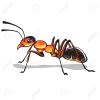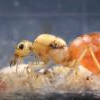- Formiculture.com
- Forums
- Gallery
- Members
- Member Map
- Chat

Larvae with brown dots
Started By
ZohMyGod
, Oct 26 2017 9:31 AM
12 replies to this topic
#1
 Offline
-
Posted October 26 2017 - 9:31 AM
Offline
-
Posted October 26 2017 - 9:31 AM
So recently all the brood was moved to the middle of the test tube.
I'm able to see a few larvae with brown spots in the middle. Is that normal?
I'm able to see a few larvae with brown spots in the middle. Is that normal?
#2
 Offline
-
Posted October 26 2017 - 9:54 AM
Offline
-
Posted October 26 2017 - 9:54 AM
Yes, I can observe what you are speaking of in most of my species.
“If I am killed for simply living, let death be kinder than man.” -Althea Davis
#3
 Offline
-
Posted October 26 2017 - 9:58 AM
Offline
-
Posted October 26 2017 - 9:58 AM
Yep - I think it's just the food they're eating. Since the larvae are translucent, you can see what the adult ants have been feeding them. If you give them different colored food, it will change the color of that spot.
#4
 Offline
-
Posted October 26 2017 - 11:14 PM
Offline
-
Posted October 26 2017 - 11:14 PM
The brown dot is mostly poo. Ant larvae only poop once in their life cycle just before they start to pupate (in larvae with cocoons it's visible as dot on one end of the cocoon) so the nest doesn't get filled with crap.
Edited by Serafine, October 26 2017 - 11:16 PM.
We should respect all forms of consciousness. The body is just a vessel, a mere hull.
Welcome to Lazy Tube - My Camponotus Journal
#5
 Offline
-
Posted October 27 2017 - 2:03 AM
Offline
-
Posted October 27 2017 - 2:03 AM
You haven't given us enough information to come to a definitive conclusion. If you can find a high quality photo on the internet that looks like what you're seeing, that may be helpful.
byFormica® is the manufacturer of the iconic nectar feeders and Sunburst Ant Nectar.
byFormica ant products always deliver consistent performance, convenience,
and reliability, making them among the most beloved ant foods and kit enjoyed by
ant keeping enthusiasts worldwide. For more information, visit www.byFormica.com.
#6
 Offline
-
Posted October 27 2017 - 10:10 AM
Offline
-
Posted October 27 2017 - 10:10 AM
meconium...in other words poop and waste from the larvae. they only poop once to avoid the mess.
Ant Species kept
Temnothorax Longispinosus.-Journal(discontinued)-(formerly)
Camponotus Noveboracensis (formerly)
Camponotus Nearticus-formerly
Tetramorium sp.-formerly
Camponotus Pennsylvanicus Queen & brood.-formerly
Tapinoma Sessile-Journal (3 queen colony)-formerly
Tapinoma Sessile #2 (2 queen colony)-formerly
Aphaenogaster Picea-Journal-active
Crematogaster sp.(Cerasi or Lineolata) Queen with 3 workers and brood-formerly
Crematogaster sp. #2 (Cerasi or Lineolata) Queen with brood-formerly
Formica sp. polygenus-active 300+ workers-active
Formica Subsericea-active 25+ workers-active
Myrmica Rubra 400+ workers 3 queens-active
#7
 Offline
-
Posted October 27 2017 - 11:51 AM
Offline
-
Posted October 27 2017 - 11:51 AM
Yep, it is poop. They shoot out the poop when they pupate.
Hawaiiant (Ben)
Keeper of
Miniature Labradoodle
Baby Wolf Spider
Mud Dauber wasp larvae
Ochetellus Glaber
Solenopsis Geminata
Brachymyrmex Obscurior
Cardiocondyla Emeryi
Tetramorium Bicarinatum
Plagiolepis Alluaudi
Anoplolepis Gracilipes
Technomyrmex Difficilis
Pheidole Megacephala
Aholehole fish
Cowrie snail
Sea Fan Worm
100+ sea squirts
Tree seedlings
Ghost Crab
Day Gecko
Small Fat Centipede
Endemic Lacewing larva
Vernal Pool shrimps
Keeper of
Miniature Labradoodle
Baby Wolf Spider
Mud Dauber wasp larvae
Ochetellus Glaber
Solenopsis Geminata
Brachymyrmex Obscurior
Cardiocondyla Emeryi
Tetramorium Bicarinatum
Plagiolepis Alluaudi
Anoplolepis Gracilipes
Technomyrmex Difficilis
Pheidole Megacephala
Aholehole fish
Cowrie snail
Sea Fan Worm
100+ sea squirts
Tree seedlings
Ghost Crab
Day Gecko
Small Fat Centipede
Endemic Lacewing larva
Vernal Pool shrimps
#8
 Offline
-
Posted October 27 2017 - 3:51 PM
Offline
-
Posted October 27 2017 - 3:51 PM
Yep, it is poop. They shoot out the poop when they pupate.
meconium...in other words poop and waste from the larvae. they only poop once to avoid the mess.
The brown dot is mostly poo. Ant larvae only poop once in their life cycle just before they start to pupate (in larvae with cocoons it's visible as dot on one end of the cocoon) so the nest doesn't get filled with crap.
The user hasn't provided any additional information, and we're still guessing like it's a game of charades.
Did anyone even read the question closely? Why would a meconium be in "the middle" of a larva? What species are we talking about? Has anyone seen a photo from the user showing precisely what is being described?
Edited by drtrmiller, October 27 2017 - 4:37 PM.
byFormica® is the manufacturer of the iconic nectar feeders and Sunburst Ant Nectar.
byFormica ant products always deliver consistent performance, convenience,
and reliability, making them among the most beloved ant foods and kit enjoyed by
ant keeping enthusiasts worldwide. For more information, visit www.byFormica.com.
#9
 Offline
-
Posted October 27 2017 - 4:50 PM
Offline
-
Posted October 27 2017 - 4:50 PM
Why would a meconium be in "the middle" of a larva?
I was wondering the same thing.
#10
 Offline
-
Posted October 27 2017 - 5:18 PM
Offline
-
Posted October 27 2017 - 5:18 PM
I guarantee you it looks like this (there's not much else it could be):

We should respect all forms of consciousness. The body is just a vessel, a mere hull.
Welcome to Lazy Tube - My Camponotus Journal
#11
 Offline
-
Posted October 27 2017 - 5:45 PM
Offline
-
Posted October 27 2017 - 5:45 PM
"Larvae with brown spots in the middle" - the first thing that came to mind was the color of the food they were being fed (insects/proteins are usually brown).
I see it all the time in many different species. Do they look similar to the larvae in this youtube?
Instagram:
nurbsants
YouTube
California Ants for Sale
Unidentified Myrmecocystus
https://www.formicul...ls-near-desert/
Undescribed "Modoc"
https://www.formicul...mp-ca-5-4-2017/
Camponotus or Colobopsis yogi:
https://www.formicul...a-ca-1-28-2018/
Camponotus us-ca02
https://www.formicul...onotus-us-ca02/
Unidentified Formica
https://www.formicul...l-ca-6-27-2020/
Pencil Case and Test Tube Formicariums
https://www.formicul...m-and-outworld/
Bloodworm Soup
https://www.formicul...bloodworm-soup/
#12
 Offline
-
Posted October 27 2017 - 5:51 PM
Offline
-
Posted October 27 2017 - 5:51 PM
I guarantee you it looks like this (there's not much else it could be):
The user didn't specify whether the brown spot was internal or external. A "meconium" is the waste expelled at the end of the larva stage. The internal pigmented matter in the above photo is simply considered undigested food in the larval midgut, the color of which is dependent on diet. The dot is not considered "meconial" until it reaches the hindgut immediately prior to pupation, just as food we humans ingest is not considered stool until it reaches the colon, after first passing through the stomach and then small intestine.
The breakdown likely comes from the careless use of the term some have used in recent YouTube videos. Here is some expert writing from Tschinkel's "The Fire Ants" that better explains how the term should be used in scientific writing:
Edited by drtrmiller, October 27 2017 - 6:31 PM.
- nurbs likes this
byFormica® is the manufacturer of the iconic nectar feeders and Sunburst Ant Nectar.
byFormica ant products always deliver consistent performance, convenience,
and reliability, making them among the most beloved ant foods and kit enjoyed by
ant keeping enthusiasts worldwide. For more information, visit www.byFormica.com.
#13
 Offline
-
Posted October 28 2017 - 5:45 AM
Offline
-
Posted October 28 2017 - 5:45 AM
Oh.
Hawaiiant (Ben)
Keeper of
Miniature Labradoodle
Baby Wolf Spider
Mud Dauber wasp larvae
Ochetellus Glaber
Solenopsis Geminata
Brachymyrmex Obscurior
Cardiocondyla Emeryi
Tetramorium Bicarinatum
Plagiolepis Alluaudi
Anoplolepis Gracilipes
Technomyrmex Difficilis
Pheidole Megacephala
Aholehole fish
Cowrie snail
Sea Fan Worm
100+ sea squirts
Tree seedlings
Ghost Crab
Day Gecko
Small Fat Centipede
Endemic Lacewing larva
Vernal Pool shrimps
Keeper of
Miniature Labradoodle
Baby Wolf Spider
Mud Dauber wasp larvae
Ochetellus Glaber
Solenopsis Geminata
Brachymyrmex Obscurior
Cardiocondyla Emeryi
Tetramorium Bicarinatum
Plagiolepis Alluaudi
Anoplolepis Gracilipes
Technomyrmex Difficilis
Pheidole Megacephala
Aholehole fish
Cowrie snail
Sea Fan Worm
100+ sea squirts
Tree seedlings
Ghost Crab
Day Gecko
Small Fat Centipede
Endemic Lacewing larva
Vernal Pool shrimps
0 user(s) are reading this topic
0 members, 0 guests, 0 anonymous users



















